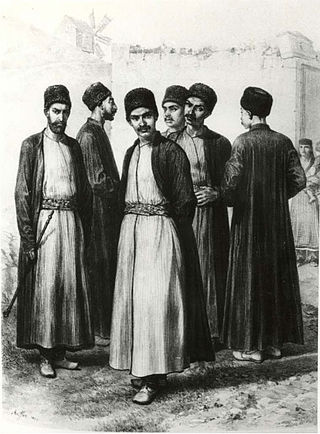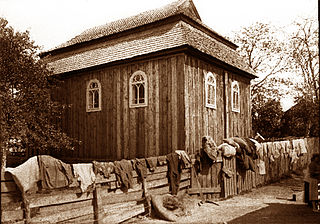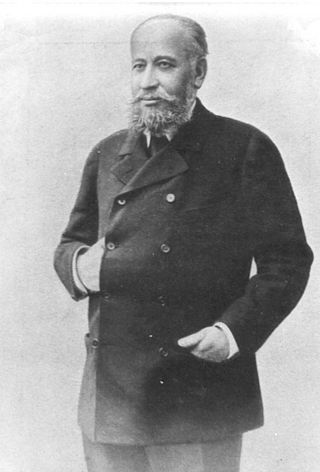
A synagogue, also called a shul or a temple, is a place of worship for Jews and Samaritans. It has a place for prayer where Jews attend religious services or special ceremonies such as weddings, bar and bat mitzvahs, choir performances, and children's plays. They also have rooms for study, social halls, administrative and charitable offices, classrooms for religious and Hebrew studies, and many places to sit and congregate. They often display commemorative, historic, or modern artwork alongside items of Jewish historical significance or history about the synagogue itself.

The Romaniote Jews or the Romaniotes are a Greek-speaking ethnic Jewish community native to the Eastern Mediterranean. They are one of the oldest Jewish communities in existence and the oldest Jewish community in Europe. The Romaniotes have been, and remain, historically distinct from the Sephardim, some of whom settled in Ottoman Greece after the expulsion of Jews from Spain and Portugal after 1492.

Zhytomyr is a city in the north of the western half of Ukraine. It is the administrative center of Zhytomyr Oblast (province), as well as the administrative center of the surrounding Zhytomyr urban hromada (commune) and Zhytomyr Raion (district). Moreover Zhytomyr consists of two so-called "raions in a city": Bohunskyi Raion and Koroliovskyi Raion. Zhytomyr occupies an area of 65 square kilometres. Its population is 261,624.
The Krymchaks are Jewish ethno-religious communities of Crimea derived from Turkic-speaking adherents of Rabbinic Judaism. They have historically lived in close proximity to the Crimean Karaites, who follow Karaite Judaism.

The Crimean Karaites or Krymkaraylar, also known as Karaims and Qarays, are an ethnicity of Turkic-speaking adherents of Karaite Judaism in Central and Eastern Europe, especially in the territory of the old Polish-Lithuanian Commonwealth and Crimea. "Karaim" is a Russian, Ukrainian, Belarusian, Polish and Lithuanian name for the community.

Berdychiv is a historic city in Zhytomyr Oblast, northern Ukraine. It serves as the administrative center of Berdychiv Raion within the oblast. It is 44 km (27 mi) south of the administrative center of the oblast, Zhytomyr. Its population is approximately 73,046.

A kenesa is an Eastern European or Persian Karaite synagogue.

House with Chimaeras or Horodetsky House is an Art Nouveau building located in the historic Lypky neighborhood of Kyiv, the capital of Ukraine. Situated across the street from the President of Ukraine's office at No. 10, Bankova Street, the building has been used as a presidential residence for official and diplomatic ceremonies since 2005. The street in front of the building is closed off to all automobile traffic, and is now a patrolled pedestrian zone due to its proximity to the Presidential Administration building.

The history of the Jews in Ukraine dates back over a thousand years; Jewish communities have existed in the modern territory of Ukraine from the time of the Kievan Rus'. Important Jewish religious and cultural movements, from Hasidism to Zionism, arose there. According to the World Jewish Congress, the Jewish community in Ukraine constitutes Europe's third-largest and the world's fifth-largest.

Moorish Revival or Neo-Moorish is one of the exotic revival architectural styles that were adopted by architects of Europe and the Americas in the wake of Romanticist Orientalism. It reached the height of its popularity after the mid-19th century, part of a widening vocabulary of articulated decorative ornament drawn from historical sources beyond familiar classical and Gothic modes. Neo-Moorish architecture drew on elements from classic Moorish architecture and, as a result, from the wider Islamic architecture.
Subbotniks is a common name for adherents of Russian religious movements that split from Sabbatarian sects in the late 18th century.

Haisyn or Haysyn is a city in central Ukraine. It serves as the administrative center of Haisyn Raion within Vinnytsia Oblast. It is located on the Sob in the eastern part of the historical region of Podolia. Its population is 25,698.

Władysław Horodecki was a Polish architect active in the Russian Empire and later in the Second Polish Republic. He is best known for his contributions in the urban development of Kyiv, with buildings such as the House with Chimaeras, the St. Nicholas Roman Catholic Cathedral, the Karaite Kenesa, and the National Art Museum of Ukraine.

The First Russian Congregation of Rodfei Sholem Anshei Kiev, known as the Kiever Synagogue or Kiever Shul, is a Modern Orthodox Jewish synagogue in Toronto, Ontario, Canada. It was founded by Jewish immigrants from Ukraine in 1912, and formally incorporated in 1914. The congregants were poor working-people, and services were led by members and held in their homes. Two houses were eventually purchased in the Kensington Market area, and in their place construction was completed on the current twin-domed Byzantine Revival building in 1927. The building was once the site of George Taylor Denison's home Bellevue.

The Brodsky Synagogue, also called the Brodsky Choral Synagogue, is an Orthodox Jewish synagogue located in Kyiv, Ukraine.

The Karaite Synagogue is a kenesa in Hasköy, Beyoğlu in Istanbul, Turkey.

Lazar Izrayilevich Brodsky was a Russian businessman of Jewish origin, sugar magnate, philanthropist and patron.
The history of the Jews in Kyiv stretches from the 10th century CE to the 21st century, and forms part of the history of the Jews in Ukraine.

The history of the Jews in Odesa dates to 16th century. Since the modern city's founding in 1795, Odesa has been home to one of the largest population of Jews in what is today Ukraine. They comprised the largest ethno-religious group in the region throughout most of the 19th century and until the mid-20th century.





















